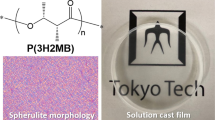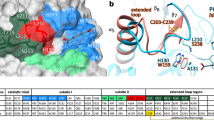Abstract
The development of non-petrochemical sources for the plastics industry continues to progress as large multinationals focus on renewable resources to replace fossil carbon1. Many bacteria are known to accumulate polyoxoesters as water-insoluble granules in the cytoplasm. The thermoplastic and/or elastomeric behaviour of these biodegradable polymers holds promise for the development of various technological applications2,3. Here, we report the synthesis and characterization of microbial polythioesters (PTEs), a novel class of biopolymers of general technological relevance. Biosynthesis of PTE homopolymers was achieved using a recombinant strain of Escherichia coli that expressed a non-natural pathway consisting of a butyrate kinase, a phosphotransbutyrylase, and a PHA synthase. Different homopolymers were produced, consisting of either 3-mercaptopropionate, 3-mercaptobutyrate, or 3-mercaptovalerate repeating units, if the respective mercaptoalkanoic acids were provided as precursor substrates to the fermentative process. The PTEs contributed up to 30% (w/w) of the cellular dry weight and were identified as hydrophobic inclusions in the cytoplasm. The chemical and stereochemical homogeneity of the purified PTEs were identified by different methods, and the estimated physical properties were compared to the oxypolyester equivalents, revealing low crystalline order and, for the poly(3-mercaptopropionate) improved thermal stability. The ability to produce PTEs through a biosynthetic route opens up new avenues in the field of biomaterials.
This is a preview of subscription content, access via your institution
Access options
Subscribe to this journal
Receive 12 print issues and online access
$259.00 per year
only $21.58 per issue
Buy this article
- Purchase on Springer Link
- Instant access to full article PDF
Prices may be subject to local taxes which are calculated during checkout



Similar content being viewed by others
References
Eissen, M., Metzger, J.O., Schmidt, E. & Schneiwind, U. 10 years after Rio-concepts on the contribution of chemistry to a sustainable development. Angew. Chem. Int. Ed. 41, 414–436 (2002).
Anderson, A.J. & Dawes, E.A. Ocurrence, metabolism, metabolic role, and industrial uses of bacterial polyhydroxyalkanoates. Microbiol. Rev. 54, 450–472 (1990).
Hocking, P.J. & Marchessault, R.H. in Chemistry and Technology of Biodegradable Polymers (ed. Griffin, G.J.L.) 48–96 (Chapman and Hall, London, 1994).
Steinbüchel, A. & Valentin, H.E. Diversity of bacterial polyhydroxyalkanoic acids. FEMS Microbiol. Lett. 128, 219–228 (1995).
Takagi, Y., Hashii, M., Maehara, A. & Yamane, T. Biosynthesis of polyhydroxyalkanoate with a thiophenoxy side group obtained from Pseudomonas putida. Macromolecules 32, 8315–8318 (1999).
Ewering Ewering, C., Lütke-Eversloh, T., Luftmann, H. & Steinbüchel, A. Identification of novel sulphur-containing bacterial polyesters: biosynthesis of poly(3-hydroxy-S-propyl-ω-thioalkanoates) containing thioether linkages in the side chains. Microbiology 148, 1397–1406 (2002).
Lütke-Eversloh, T., Bergander, K., Luftmann, H. & Steinbüchel, A. Identification of a new class of biopolymer: bacterial synthesis of a sulphur containing polymer with thioester linkages. Microbiology 147, 11–19 (2001).
Lütke-Eversloh, T., Bergander, K., Luftmann, H. & Steinbüchel, A. Biosynthesis of poly(3-hydroxybutyrate-co-3-mercaptobutyrate) as a sulphur analogue to poly(3-hydroxybutyrate) (PHB). Biomacromolecules 2, 1061–1065 (2001).
Lütke-Eversloh, T., Kawada, J., Marchessault, R.H. & Steinbüchel, A. Characterization of biological polythioesters: physical properties of novel copolymers synthesized by Ralstonia eutropha. Biomacromolecules 3, 159–166 (2002).
Liu, S.-J. & Steinbüchel, A. A novel genetically engineered pathway for synthesis of poly(hydroxyalkanoic acids) in Escherichia coli. Appl. Environ. Microbiol. 66, 739–743 (2000).
Gorenflo, V., Schmack, G., Vogel, R. & Steinbüchel, A. Development of a process for the biotechnological large-scale production of 4-hydroxyvalerate-containing polyesters and characterization of their physical and mechanical properties. Biomacromolecules 2, 45–57 (2001).
Hocking, P.J. & Marchessault, R.H. Microstructure of poly[(R,S)-β-hydroxybutyrate] by 13C NMR. Macromolecules 28, 6401–6409 (1995).
Morgan, K.H., Furneaux, R.H. & Larsen, N.G. Solid state NMR studies on the structure of starch granules. Carbohyd. Res. 276, 387–399 (1995).
Horii, F, Yamamoto, A., Hirai, A. & Kitamaru, R. Structural study of amylose polymorphs by crosspolarization magic-angle-spinning NMR spectroscopy. Carbohyd. Res. 160, 29–40 (1987).
Suehiro, K., Chatani, Y. & Tadokoro, H. Structural studies of polyesters. VI. Disordered crystal structure (Form II) of poly(β-propiolactone). Polym. J. 7, 352–358 (1975).
Okamura, K. & Marchessault, R.H. Conformation of Biopolymers Vol. 2 (ed. Ramachandran, G.N.) 709–720 (Academic, London, 1967).
Marchessault, R.H., Morikawa, H., Revol, J.F. & Bluhm, T.L. Physical properties of a naturally occurring polyester: Poly(β-hydroxyvalerate)/poly(β-hydroxybutyrate) Macromolecules 17, 1882–1884 (1984).
Cornibert, J. & Marchessault, R.H. Physical properties of poly-β-hydoroxybutyrate IV. Conformational analysis and crystalline structure. J. Mol. Biol. 71, 735–756 (1972).
Marvel, C.S. & Kotch, A. Polythiolesters. J. Am. Chem. Soc. 73, 1100–1102 (1951).
Sandler, S.R. in Organic Chemistry Vol. 29-III (ed. Wasserman, H.H.) 46–72 (Academic, San Diego, USA, 1996).
Lütke-Eversloh, T., Steinbüchel, A. & Ewering, C. Sulfur containing polyhydroxyalkanoate compositions and method of production. US patent 60,226,139 (2000).
Jones, M. Microbial alternative to plastics. Microbiol. Today 28, 36 (2001).
Wood, F. Antibacterial biopolymer may aid healing. Chem. Ind. 3, 64 (2001).
Sambrock, J., Fritsch, E.F. & Maniatis, T. Molecular Cloning: A Laboratory Manual 2nd edn (Cold Spring Harbor Laboratory, Cold Spring Harbor, New York, 1989).
Schjånberg, E. Pentensäure und Thioessigsäure. Chem. Ber. 74, 1751–1759 (1941).
Arnold, M. Histochemie. Einführung in die Grundlagen und Prinzipien der Methoden (Springer, Berlin, 1968).
Spurr, A.R. A low-viscosity epoxy resin embedding medium for electron microscopy. J Ultrastruct. Res. 26, 31–43 (1969).
Brandrup, J., Immergut, E.H. & Grulke, E.A. (eds) Polymer Handbook 4th edn (Wiley, New York 1999).
Acknowledgements
We thank Ursula Malkus for expert electron microscopic preparation of the specimens and for taking the TEM micrographs, and Gudrun Kiefermann (Institut für Medizinische Physik und Biophysik, WWU Münster) for photographic work. Further spectroscopic analysis of PTE samples by Heinrich Luftmann and Klaus Bergander (Institut für Organische Chemie, WWU Münster) is gratefully acknowledged. Paul Xia performed the 13C high-resolution NMR experiments.
Author information
Authors and Affiliations
Corresponding author
Ethics declarations
Competing interests
The authors declare no competing financial interests.
Rights and permissions
About this article
Cite this article
Lütke-Eversloh, T., Fischer, A., Remminghorst, U. et al. Biosynthesis of novel thermoplastic polythioesters by engineered Escherichia coli. Nature Mater 1, 236–240 (2002). https://doi.org/10.1038/nmat773
Received:
Accepted:
Published:
Issue Date:
DOI: https://doi.org/10.1038/nmat773
This article is cited by
-
Invention of biobased polymer alloys and their application in plastic automobile parts
Polymer Journal (2023)
-
Recent advances in enantioselective ring-opening polymerization and copolymerization
Communications Chemistry (2023)
-
Statistical optimization studies for polyhydroxybutyrate (PHB) production by novel Bacillus subtilis using agricultural and industrial wastes
International Journal of Environmental Science and Technology (2019)
-
Recent developments in non-biodegradable biopolymers: Precursors, production processes, and future perspectives
Applied Microbiology and Biotechnology (2019)
-
Novel extracellular medium-chain-length polyhydroxyalkanoate depolymerase from Streptomyces exfoliatus K10 DSMZ 41693: a promising biocatalyst for the efficient degradation of natural and functionalized mcl-PHAs
Applied Microbiology and Biotechnology (2015)



